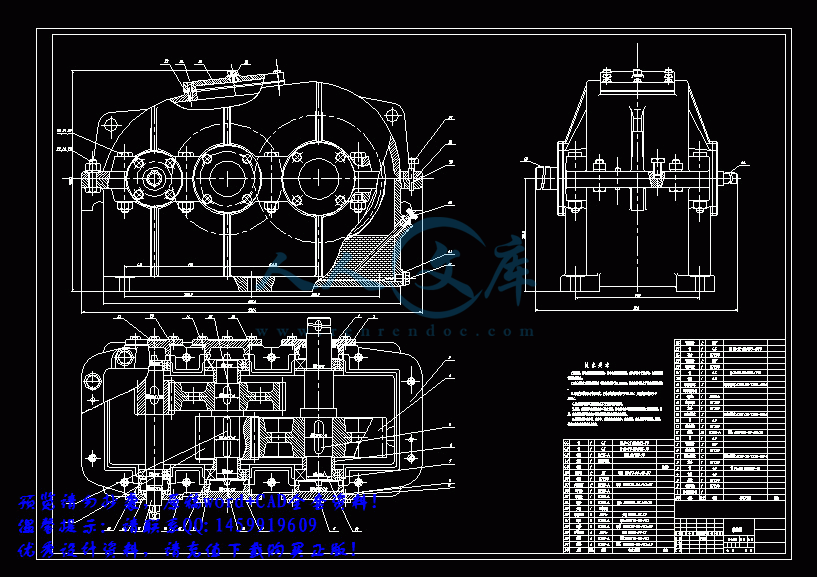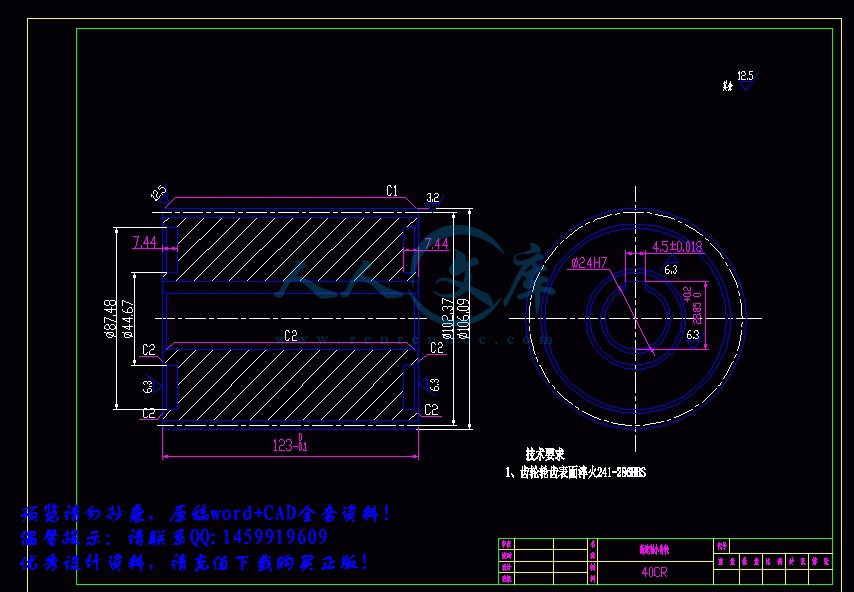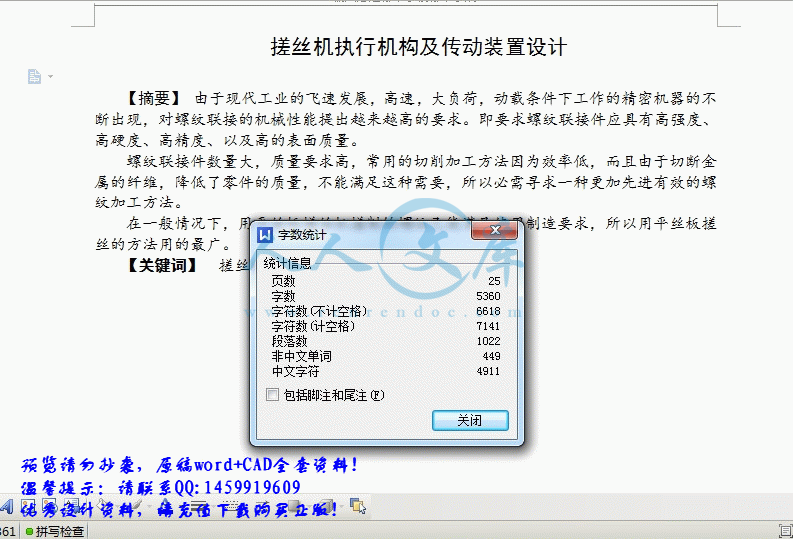搓丝机的设计
搓丝机执行机构设计
搓丝机传动装置设计
搓丝机执行机构及传动装置设计【优秀机械传动装置设计+5张CAD图纸】
【带任务书+开题报告+外文翻译+25页@正文5300字】【详情如下】【需要咨询购买全套设计请加QQ1459919609 】.bat
任务书.doc
外文翻译.doc
开题报告.doc
总装配图示意图.dwg
搓丝机的设计正文.doc
齿轮及减速器.dwg
附件2:
毕业论文(设计)任务书
论文(设计)题目
搓丝机执行机构及传动装置设计
论文(设计)选题目的、工作任务:
近年来,机械制造正朝着高精、高效、模块、组合、通用、经济方向发展。毕业设计更是当代大学生毕业前的一门必修课。它讲综合考察学生对前序课程的掌握及综合创新能力。通过对一个机械系统的总体设计使学生在实践中对机械系统的各个组成部分,所学过的理论知识,设计过程的基本步骤和基本原理都有了较深层次的认识。与此同时,可以充分发挥学生的创新能力。
本课题是对搓丝机执行机构及传动装置进行合理有效的设计。通过训练,不但使学生牢固掌握了基本知识,掌握了基本技能,熟悉了机械设计的全过程,还能体会到机械设计制造在国民经济中的基础性地位。
目前资料收集情况(含指定参考资料):
我通过书籍的查阅基本基本了解了搓丝机的发展历程、明确了本次毕业设计的目的。在此期间我查阅了《机械原理》第七版,孙桓、陈作模、葛文杰主编,西北工业大学机械原理及机械零件教研室编,高等教育出版社、《机械原理课程设计指导书》,郭红利 主编,西北农林科技大学、《机械设计手册》(三版),吴宗泽 主编,化学工业出版社、《材料力学》(第四版),刘鸿文 主编,高等教育出版社、《理论力学》(第七版),哈尔滨工业大学理论力学教研室、《AutoCAD2007》 机械设计绘图应用教程 陈敏 刘晓旭 主编重庆大学出版社。
搓丝机执行机构及传动装置设计
【摘要】 由于现代工业的飞速发展,高速,大负荷,动载条件下工作的精密机器的不断出现,对螺纹联接的机械性能提出越来越高的要求。即要求螺纹联接件应具有高强度、高硬度、高精度、以及高的表面质量。
螺纹联接件数量大,质量要求高,常用的切削加工方法因为效率低,而且由于切断金属的纤维,降低了零件的质量,不能满足这种需要,所以必需寻求一种更加先进有效的螺纹加工方法。
在一般情况下,用平丝板搓丝机搓制的螺纹已能满足使用制造要求,所以用平丝板搓丝的方法用的最广。
【关键词】 搓丝机 执行机构 传动装置 螺纹
Rub the design implementation mechanism and a transmission wire machine
【Abstract】As the rapid development of modern industry, high speed, high load, the dynamic precision machine load work under the conditions of the emerging, put forward higher requirements on the mechanical properties of screw thread.Requested that the threaded joints with high strength, high hardness, high precision, and high surface quality.
Threaded connection piece of large quantity, high quality requirements, cutting method commonly used because of low efficiency, but also because of cutting metal fiber, reducing the quality of the parts, can not meet this need, so it is necessary to seek a more advanced thread effective processing method.
In general, with flat screw die flat die thread rolling machine rolling system has been able to meet the manufacture requirements, so the method with flat screw die thread rolling of the most widely used.
【Key words】Thread rolling machine Actuator Transmission Thread
前 言
本设计为机械设计基础课程设计的内容,是先后学习过机械制图、机械原理、机械设计、工程材料、加工工艺学等课程之后的一次综合应用。本设计说明书是对搓丝机传动装置设计的说明,搓丝机是专业生产螺丝的机器,使用广泛,本次设计是使用已知的使用和安装参数自行设计机构形式以及具体尺寸、选择材料、校核强度,并最终确定形成图纸的过程。通过设计,我们回顾了之前关于机械设计的课程,并加深了对很多概念的理解,并对设计的一些基本思路和方法有了初步的了解和掌握。
目 录
前言1
目录1
轴辊搓丝机传动装置的设计2
一 课程设计题目2
1轴辊搓丝机传动装置设计2
2数据表2
二 拟定传动方案及方案比较4
三 传动装置设计5
1 机构初步设计5
2 设计参数5
四 带传动主要参数及几何尺寸计算6
五 齿轮传动设计计算7
1低速级7
2高速级11
六 轴的设计与校核11
1初估轴径11
2轴强度校核12
1 高速轴12
2 中间轴12
3 低速轴14
七 轴承的选择与校核15
1 高速轴轴承
2 中间轴轴承
3 低速轴轴承
八 键的选择与校核17
九 减速器箱体各部分结构尺寸18
1 箱体18
2 润滑及密封形式选择19
3 箱体附件设计19
十 总结与建议21
十一 参考文献22
轴辊搓丝机传动装置的设计
一 课程设计题目
(1)设计背景
搓丝机用于加工轴辊螺纹,基本结构如上图所示,上搓丝板安装在机头4上,下搓丝板安装在滑块3上。加工时,下挫丝板随着滑块作往复运动。在起始(前端)位置时,送料装置将工件送入上、下搓丝板之间,滑块向后运动时,工件在上、下搓丝板之间滚动,搓制出与搓丝板一致的螺纹。搓丝板共两对,可同时搓制出工件两端的螺纹。滑块往复运动一次,加工一个工件。








 川公网安备: 51019002004831号
川公网安备: 51019002004831号